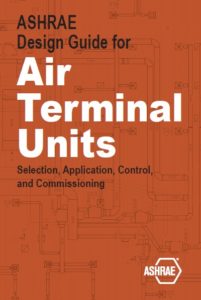ASHRAE Design Guide for Air Terminal Units Selection, Application, Control, and Commissioning 2017
ASHRAE Design Guide for Air Terminal Units Selection, Application, Control, and Commissioning 2017
ASHRAE Design Guide for Air Terminal Units Selection, Application, Control, and Commissioning 2017 was written in regards to current North American codes, standards, and design practices. It is intended to aid design engineers in selecting types of air terminal units and to explain methods for sizing units while maximizing occupant comfort and energy efficiency. It also details how to meet sound requirements and how to estimate life-cycle costs. The authors’ intent was to cover the existing product base as well as new appli-cation and component improvements.
Air terminal units play an important role in the energy consumption of a building and ultimately the comfort of occupants, both acoustic and thermal. This design guide was created with the goal of producing a best practice guide to aid in the selection of air terminal units by design engineers. The team that produced this guide comprised a consulting engineer, manufacturers of air terminal units, a balancing commissioning and testing engineer, and a manufacturer’s representative.
You can also Read Guidelines for Design and Construction of Hospitals and Outpatient Facilities 2014 1st Edition
ASHRAE Design Guide for Air Terminal Units Selection, Application, Control, and Commissioning 2017
- PREFACE
![ASHRAE Design Guide for Air Terminal Units Selection]()
- ACKNOWLEDGMENTS
- ACRONYMS
- WHY USE THIS GUIDE?
- AIR TERMINAL UNIT TYPES
- HISTORY AND ENERGY
- HVAC ACOUSTICS
- HVAC CONTROLS
- AIR TERMINAL UNIT SELECTION
- COMPARING MANUFACTURERS’ PRODUCT CERTIFICATION DATA
- BUILDING ENERGY MODELING
- LIFE-CYCLE COST ANALYSIS
- STANDARDS
- TESTING, BALANCING, AND COMMISSIONING
- AIR TERMINAL UNIT APPLICATIONS IN HEALTH CARE FACILITIES
Engineers face numerous challenges and competing constraints when designing mechanical systems for owners and operators. Owners have been challenging engineers to design systems that are more energy efficient than previous designs and have lower maintenance costs yet have low first cost.
The competing constraints have stretched engineering design fees, forcing engineers and designers to use old rules of thumb and practices and foregoing today’s high performance systems and practices. Most of this comes from the way engineers where mentored, seldom questioning certain design practices.
Download
1st Link Here
2nd Link Here


Comments are closed.